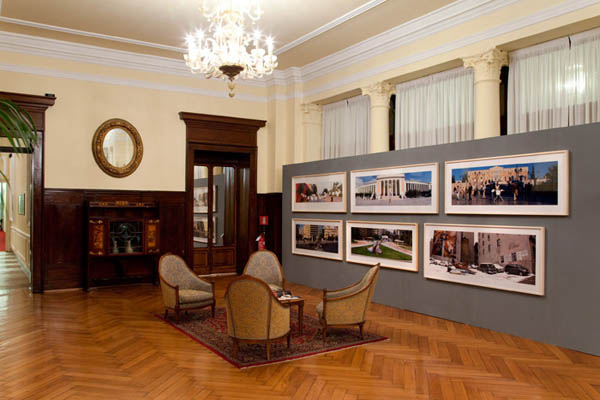Greece - Venia Bechrakis
Where is my home?
Over the past years, a younger generation of artists has demonstrated a rekindled interest in the city and the home. And though it is a known fact that art’s early twentieth century avant-garde plunged head on into the religious intoxication of the big city, in our days such references tend to take on a more personal quality; they are less strident; and the metaphors are sophisticated and paradoxical. Today’s new art may be following and perhaps completing a turn signaled by the decade of the 20s, and, later on, the 60s, yet it differs in terms of mood and spirit: nihilism and a self-reflexive formalism have been replaced by a new sensibility favoring subtle acts of signification, by an attraction to the city as mediator in interpersonal relations and by the embodied anthropogeography of dwelling. It is in terms of this trend that we may define Venia Bechrakis’ photographs. To start with, I shall focus on three qualities that seem specific to her work and are readily identifiable: First, the female quality of her photographic self-portraits, which is the result of an ironic commentary of certain consumer and domestic patterns of behavior. Second, an act of reversal that turns the inside into the outside: “T he road becomes a home for the wanderer (flâneur),” wrote Walter Benjamin, “who feels at home amidst the façades of buildings, as the bourgeois does inside his four walls”. And, third, the fact that these extimacies* are not always the result of digital manipulation of the image, but also the result of specific physical action carried out in either public or domestic space. As Edward Soja observes, “in socially produced space, spatiality may be defined by the physical space of the material world and by the mental space of the intellect and of representation, each of which is used and integrated in the construction of spatiality, but cannot be thought as its equivalent” (Postmodern Geographies). In any case, both the documentation of a direct physical action in space and the manipulation by means of photoshop of a series of displacements and paradoxes, take here the place of collage in order to place the self-documented body in a different context. This observation leads us to infer the following: what actually marks these self-portraits is the quality of heterogeneity and of a non-organic type of representation. Rosalind Krauss maintained that the aim of collage was to place emphasis “on the gap between one fragment of reality and another” (AmourFou. PhotographyandSurrealism). If the realist organic work of art attempted to reconcile the natural world with culture, then the non-organic quality of collage simply plays with reality’s fascinating heterogeneity. I am not at all sure that we have to be skeptical of the fact that the methods of the avant-garde have lost their former, heroic character to become the property of mass culture. Besides, the city itself, much like the contemporary dwelling, is no longer a harmonious thing, subject to complete control. New technologies of the image contribute to a reality of reciprocal overlapping: architecture seems to be enhancing its artistic character, as art practices increasingly seem to be borrowing elements from architecture; the epicenter being always none other that the adventure of perception, the vertigo of the gaze. Today, the quality of the city, as much as that of the home, does not only depend on the needs they necessarily serve, but also on the power of the imagination. And that was already sensed by German architect Karl Friedrich Schinkel as early as in 1834, when he designed Otto’s pharaonic palace on the Acropolis of Athens without in fact ever having stepped foot in Greece. Here then is an early instance of non lieu apotheosis, a notion to which all seem to refer today. But we can go ever further back, if you will, to El Greco’s magnificent misrepresentation of Toledo (1595-1600), in which he arbitrarily shifted the location of the river and the belfry, changing the place of buildings. What is more important today, though, is the ability of contemporary art to transform the most commonplace, mundane thing into something special. All readings of the city and the dwelling are by necessity a misreading. The only possible interpretation is a misinterpretation. The new alliance between art practices and perceptions of space has first and foremost to do with the function of the image. “This seeking for my home (…) it eateth me up”, Nietzsche writes in Thus Spake Zarathustra: “Where is my home? For it do I ask and seek, and have sought, but have not found it.” It is a question still relevant today; a question that somehow seems to resound through Venia Bechrakis’ photographs…
*Extimacy: English rendition of a neologism coined by psychoanalyst Jacques Lacan, namely extimité [from the prefix ex (exterieur) and the French word intimite (intimacy)].
Text by Yorgos Tzirtzilakis
